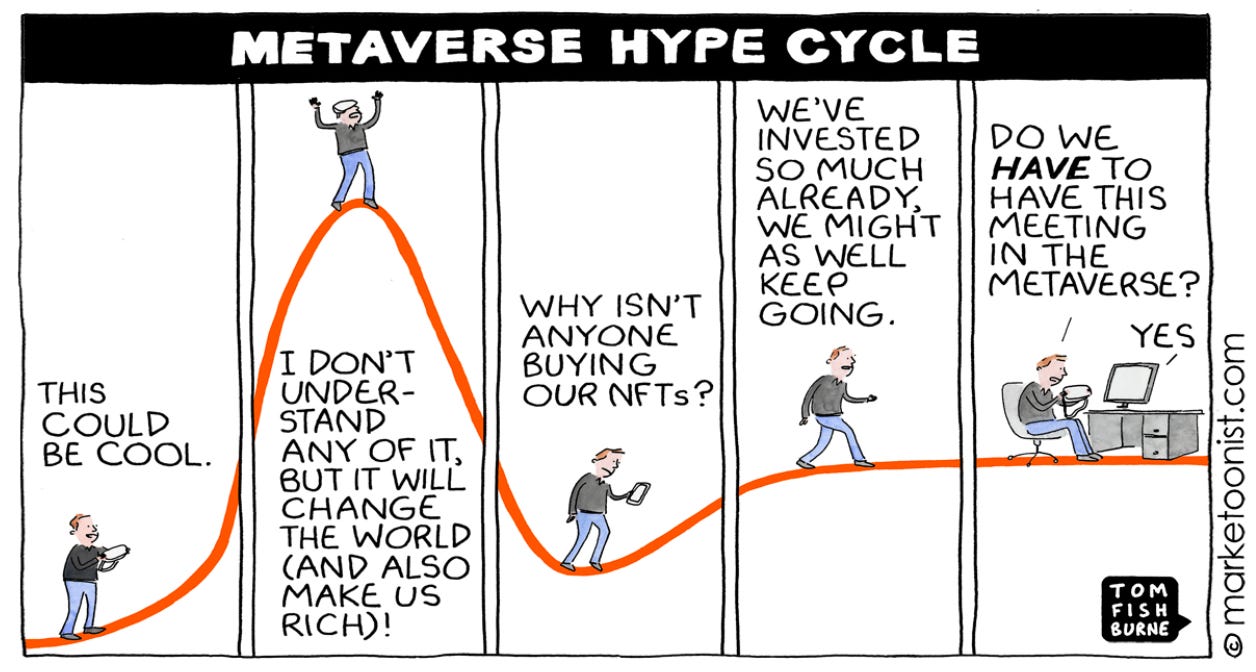The market viability of virtual reality and augmented reality tech have suddenly captured the business community’s imagination after being dismissed for most of 2023. Apple’s stunning demo of its Vision Pro “spatial computing” headset at Monday’s WWDC showed why industry leaders are calling this a “game-changer.”
Like most hype cycles, the road to mixed reality acceptance has been a long and rocky one. I’ve personally been on it for over a decade.
And projections, especially ones made early on, can be misleading — just like hype cycles themselves.
Keeping that in mind, the forecast for mixed reality appears strong. And as Apple’s Vision Pro (self-described as a “spatial computing” device) and more competing products enter the market, the space is likely to inspire even greater confidence.
According to Goldman Sachs, AR and VR are expected to grow into a $95 billion market by 2025.
Goldman Sachs’ estimate appears to validate an old one from Gartner.
Back in 2015, just as VR was having its first encounter with the Hype Cycle, Gartner warned that it would take five- to 10 years for immersive tech to make its way into mainstream adoption. Gartner initially classified “VR” and “AR” separately before combining the elements into the term “metaverse”...which still holds a stigma with consumers and businesses alike.
According to Gartner’s annual Hype Cycle report, VR was positioned on the "Slope of Enlightenment" between "Autonomous Field Vehicles" and "Gesture Control" in terms of attaining a measure of feasibility.
Hitting the Bricks
Debates over Apple’s bet on immersive experiences are likely to continue for a while though. (“I don’t like the ski goggle look,” “$3500? I’ll wait for version 10.” “Why do I need a giant monitor with 23 million pixels?”).
But consider the Analog Motorola DynaTAC 8000X (image below). It was among the first hand-held phones, introduced in 1983 for the head-spinning price of… $4000. Adjusted for inflation, that price tag is equivalent to $12,183.25 today.
When these bricks came out, there was genuine excitement about the new technology. The idea of a portable phone was widely viewed as revolutionary. At the same time, no one thought, “Okay, everyone is going to put gift wrapped bricks under the tree at holiday time.” Most observers felt that this was simply pointing to the future, where these devices would be slimmer, lighter, and cost a lot less.
And that’s just what happened over the past decade.
I don’t think we’ll have to wait 40 years for mixed reality to become a fully integrated part of our home and work lives, as well as a primary way to access education, health services, and entertainment.
Let’s look back just seven years ago.
20/20 Visions of VR
I produced one of the first conferences, Virtual Reality Summit 20/20, dedicated to exploring the possibilities of what Apple is calling spatial computing (or what was previously and variously called “the metaverse.”).
The VR Summit 20/20 was backed by the parent company of TV industry trade publications, Broadcasting & Cable and Multichannel News. The October 2016 event was among the earliest and it provided a rare chance for investors and enterprises to wrap their minds around the potential for VR content, software and applications.
It was just two years after Facebook had acquired the VR gear-maker Oculus for $2 billion to fulfill Mark Zuckerberg’s years-long ambitions to dominate that space. (The Oculus brand would be killed in Oct. 2021, when FB the company became Meta. Oculus’s DNA does live on in Meta’s Quest VR product line, which has an entry price of around $300.)
As we were planning the summit, I remember taking my kids to Best Buy to purchase our first versions of Samsung's device at the time, the Gear VR. (In May 2020, Samsung, way out in front of Meta, would sunset that brand.)
At the time of the VR Summit, Samsung, Google and Sony were considered the leaders who would take VR to the public. There was no talk about Facebook (Meta) or Apple.
The excitement was real then. And despite some of the expected snark about Vision Pro, I feel it again about the potential of virtual and mixed reality.
Still, this time is different.
credit: Midjourney
Apple Is Always Refining
It has to do with Apple’s timing and its marketing.
When Apple decides to enter a category, it simply takes on a higher sense of viability. Apple did this with MP3 players and the iPod. It did the same with smartphones and touchscreens with the iPhone.
Let’s not forget that it wasn’t until the second version of the iPhone that mobile entered warp speed. The opening of the iPhone App Store exploded the limits of Apple’s and any other device maker’s mobile walled garden.
Apple has always been open to the marketplace demands, despite Steve Jobs’ famous dictum that it’s the company’s responsibility to anticipate what the customer wants before they say so.
After all, Jobs had declared that web apps, not smartphone apps, would be the future. But when developers cried out for a place on the iPhone itself, Apple relented and a new mobile future was born.
There were other things now considered table stakes that the first iPhone didn’t have. It didn’t have video recording capabilities. There was no flashlight or GPS. There wasn’t even a front-facing camera.
Apple is always developing, always refining, always enhancing. The Vision Pro is the first version. There will almost certainly be a second in 2025 and a third in 2026. The VR space will be maturing then. As amazed — or unimpressed — as you might be at this week’s presentation, I’m certain the fun times are ahead.
So as we shake our heads at Vision Pro’s cost, its tether to a battery pack, the lack of applications, games, and content (except for Disney+, at the moment) dedicated to Vision Pro, let’s take a breath and imagine the feel of those 1983 Motorola bricks.








